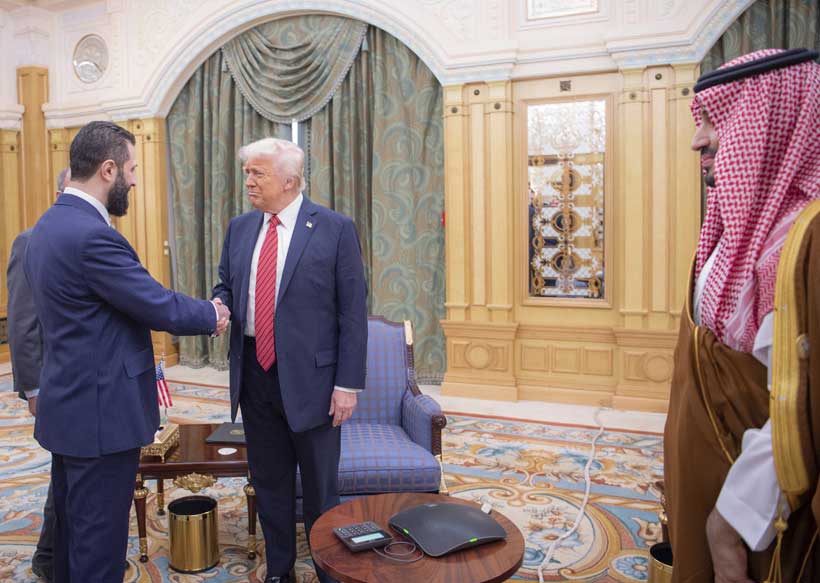The image of Donald Trump shaking hands with Ahmad al-Sharaa, Syria’s current leader, in Riyadh is one that, until recently, would have seemed unimaginable. Al-Sharaa, once on the U.S. most-wanted list with a $10 million bounty for information leading to his capture, now stood alongside Trump to discuss Syria’s future. This meeting, along with Trump’s decision to lift sanctions on Syria, raises a fundamental question: Is America’s war on terror a principled, genuine fight—or a tool serving Washington’s shifting political interests?
A Puzzling Encounter
Trump’s meeting with Ahmad al-Sharaa during his highly publicized Middle East tour sparked regional and global astonishment. Al-Sharaa, formerly known as Abu Mohammad al-Julani, was the leader of Jabhat al-Nusra, a group the U.S. designated as a terrorist organization in 2013, offering $10 million for information on him. Following the meeting, Trump announced plans to normalize relations with Syria’s new government and lift sanctions, calling it an opportunity for a “fresh start” for the war-torn nation. This shift stands in stark contrast to the 2013 U.S. stance, when Jabhat al-Nusra was a prime target in the global war on terror.
The White House defended this move as pragmatic, citing al-Sharaa’s role in toppling Bashar al-Assad and his apparent moderation as the leader of Hay’at Tahrir al-Sham (HTS), a rebranding intended to distance the group from its al-Qaeda past. Yet the image of Trump shaking hands with a former most-wanted figure—especially in light of past U.S. actions—was deeply unsettling.
The Soleimani Paradox: A Tale of Selective Justice
To understand the implications of Trump’s meeting with al-Sharaa, we must revisit the 2020 assassination of Qassem Soleimani, commander of Iran’s Quds Force. Soleimani played a central role in fighting ISIS, particularly in Iraq and Syria, where his forces aided local militias in retaking territory. Despite this alignment with U.S. priorities, the Trump administration ordered his assassination via drone strike in Baghdad, justifying it by citing his support for groups like Hezbollah and alleged threats to U.S. interests.
The contrast is stark: Soleimani, who battled ISIS and extremist groups, was killed; al-Sharaa, once the head of an al-Qaeda affiliate, is now a diplomatic partner. This contradiction suggests that U.S. counterterrorism policy is less about eliminating extremism and more about advancing strategic interests. Soleimani’s death disrupted Iran’s regional influence—a long-standing U.S. objective—while al-Sharaa’s new role aligns with Washington’s aim to stabilize post-Assad Syria without direct military involvement.
A History of Convenient Alliances
Trump’s meeting with al-Sharaa is not an anomaly but part of a broader pattern in U.S. foreign policy. During the Cold War, the U.S. supported Afghan mujahideen against the Soviets—some of whom, like Osama bin Laden, later formed al-Qaeda. In the 1980s, Washington backed Saddam Hussein in his war against Iran, despite his clear record of atrocities, because Iraq served as a counterweight to Tehran.
In 2025, Trump’s Middle East strategy mirrors this tradition. His visit to Saudi Arabia—where he signed a $142 billion arms deal and emphasized confronting Iran—underscored a focus on strengthening allies like Saudi Arabia and Israel while selectively engaging former foes like al-Sharaa. The lifting of sanctions and talk of normalization signal a pragmatic shift, prioritizing stability and economic opportunity over old terrorist designations. This realpolitik approach aligns with Trump’s deal-making rhetoric, such as his readiness to negotiate with Iran—if it abandoned its nuclear ambitions and support for “terrorism”—even while threatening “maximum pressure.”
The Mask Slips from the War on Terror
America’s war on terror, launched after 9/11, has long been portrayed as a moral struggle against extremism. But the meeting with al-Sharaa exposes its instrumental nature. By engaging with a former terrorist leader, the U.S. reveals that its “terrorist” labels are often temporary, shifting when political or economic interests arise. Trump’s handshake with al-Sharaa sends a message to regional players: the U.S. is willing to overlook past crimes for strategic gain—a signal that may encourage other groups to pursue legitimacy through cosmetic political changes.
By contrast, the assassination of Soleimani shows the other side of that coin. His killing wasn’t just about counterterrorism—it was a strategic blow to Iran, a regional rival. Soleimani’s forces played a key role in defeating ISIS in Iraq, yet the terrorist label overshadowed his contributions to a shared objective.
A Policy of Expedience
The photo of Donald Trump shaking hands with Ahmad al-Sharaa is more than just a diplomatic snapshot—it’s a window into the dual nature of America’s counterterrorism policy. When a former al-Qaeda commander is embraced as a partner, but a general who fought ISIS is eliminated by U.S. drones, the message is clear: terrorism is a label used for convenience, not conviction. It reveals a truth the West rarely admits—principles become negotiable when interests are at stake.
As the Middle East enters a new chapter, the world watches and wonders: Is America’s war on extremism truly about security—or just another move in a geopolitical chess game for regional and global dominance?
